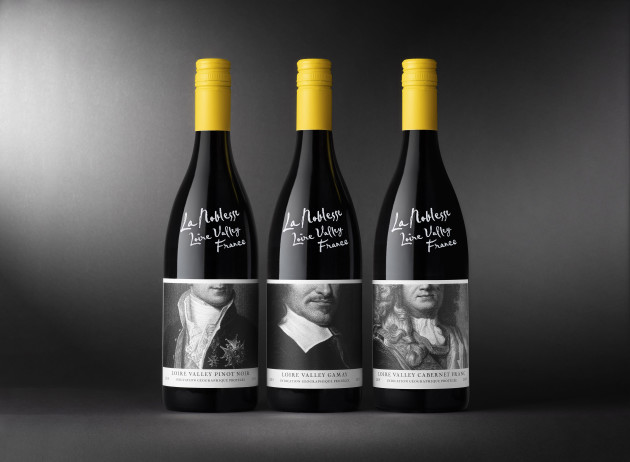
Long read: It’s time for a France re-think
Rowena Curlewis, CEO of drinks design specialist Denomination, tells us why she thinks French wine brands could afford to up the ‘badass’ design stakes when marketing overseas.
Last month the US introduced a second set of tariffs on wine imported from France, among other European countries. According to the French Federation of Wine and Spirit Exporters (FEVS), the first set cost French producers more than €600 million in 2020. The additional tax could set the country back a further €300 million.
There are all sorts of politics behind this brinkmanship, and it’s not confined to France and the US. But, putting that to one side for the moment, maybe French winemakers and exporters should take this opportunity to look within and ask themselves what they can do to improve traction abroad. Because even before these tariff wars, France was losing market share overseas.
Pardon, je n’ai pas compris
Perhaps the French have been a little reluctant to acknowledge the barrier that their language imposes on non-European buyers. In the US and Australia, for example, where French is just one of many foreign languages and local wine can meet most needs, this is a marketing obstacle. Even in the UK, where French wine has been on the shelves since Roman times, the mass market is put off by monoglot labelling, especially when there’s a New World bottle right next door that makes a lot more sense.
Just Google ‘French wine labels’. The first result to pop up is: ‘How to decipher a French wine label.’ Vintage, winery, appellation, quality level, type of wine, where it’s bottled. It’s all there, on every label. All you need to know is how to untangle and interpret all the scripted text surrounding the beautifully ornate illustration of (yet another) château.
We all know that wine is an integral part of French culture, with every region proudly producing its own variety. But when faced with rows and rows of bottles from different vineyards, châteaux and regions, it can be hard to tell them apart. Especially for people from other parts of the world.
Yes, there are strict laws governing the information that must appear on pack, but there’s scope beyond charming images of stately homes and overcrowded labels. If your label is your calling card, you need to think long and hard about how you’re going to use it to set yourself apart.
Taking a global view
We are starting to see some French winemakers take a more global view of brand design, one that opens the door to non-French-speakers and those without an in-depth knowledge of Gallic processes and culture.
It’s the brands that make it easier for non-French-speaking folk to select their preferred bottle via memorable visuals and colourways that will do better than those that allow their wines to recede into a sea of sameness.
For those that are concerned about France’s legacy, it’s important to remember that great design has the power to balance integrity, culture and disruption by understanding which rules to break and which to keep.
Rewriting the rules
Fourth Wave achieved this recently with a groundbreaking refresh of its Loire Valley brand, La Noblesse. It wanted to shake up the French wine sector with a fresh, modern and slightly irreverent twist and make it appeal to a broader audience. The resulting work shows how it’s possible to present a serious wine in a modern, disruptive way that appeals to overseas markets without compromising heritage or quality.
La Noblesse is unmistakably French and high-quality, but with stacks of attitude to open it up to new demographics. There’s an approachability, thanks to the chalk-pen branding, which mirrors the way bottles are priced-up in French wine shops. Humour is achieved by depicting noblemen on the labels with the tops of their heads chopped off!
A brand that has taken things a step further is Enfant Terrible, which has gone so far as to ‘deface’ traditional-looking labels to give them stand-out.
When looking at Côtes du Rhône in the UK market, the producer found that most of the wines on offer had very classic packaging. As a young and dynamic winemaker, Enfant Terrible wanted the brand to be a quality Côtes du Rhône offering but with real personality and charm. It’s young, precocious and rule-breaking. But it’s still intrinsically French, authentically Côtes du Rhône, and with a personality to match its name.
Treading a fine line
It is possible to balance tradition and modernity, quality and disruption, formality and informality. And by doing something that no one has ever done before, you can be a bit ‘badass’ without inflicting damage.
The French wine export market is contracting, so doing nothing isn’t an option. What brands need to understand is that it is perfectly possible to communicate with a much broader demographic without negatively impacting on cherished heritage. Whatever happens next with these tariff wars, French wine needs to be ready to take on the world.
Top photo: Denomination's redesign for La Noblesse
Keywords:
- wine
- US
- France
- tariffs
- CEO
- french
- imported
- second
- month
- introduced
- among
- marketslast
- ‘badass’ approach
- overseas marketslast
- marketslast month
- france among
- wine imported
- cost french producers
- european countries according
- overseas marketslast month
- thinks french wine
- french wine brands
- FEVS








